Everyone knows that our lungs are the major organ in our respiratory system, that our brain is central to our nervous system and that our stomach and intestines are partners in our digestive system.
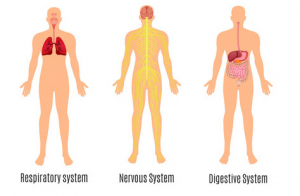
How does that connect to organizing? Just look at the word: there is an ORGAN inside organizing!
Our bones — amazing organs within our skeletal system — form the structure of our bodies while they protect our internal organs. With the help of ligaments and tendons, our skeletal system allows us to move.
 Let’s look at our households like our bodies — and see ORGANizing from an interdependent, systemic perspective:
Let’s look at our households like our bodies — and see ORGANizing from an interdependent, systemic perspective:
• providing structure and support
• filtering toxins (clutter)
• creating space for nourishment
• allowing time to digest our days
• minimizing distractions
As the daughter of a D.O., the osteopathic approach always takes the whole person into consideration. Likewise, I consider the whole household when organizing.
 On that note, let’s all head into 2019, protecting our:
On that note, let’s all head into 2019, protecting our:
• organizing time like our brains
• organizing framework as we maintain our posture
• organizing schedule as routinely as brushing our teeth
• and use our ORGANizing muscles to stay healthy!
Happy New Year
As a residential professional organizer, I visit lots of homes. One household system that is quick to fall apart and overwhelm a person is LAUNDRY.
I have strong opinions on laundry:
• dark and light clothing should be separated (my children do not all agree)
• “laundry” is not done until it is all put away
You don’t have to share those views, but I see on a weekly basis how the “putting away” is where the system breaks down. Most of us are pretty good starting the laundry process. There is an obvious and inevitable external motivation to wash clothes when one runs out of clean socks or underwear. Many people are also decent at shifting the wet clothes over to the dryer. The widespread access to timers on our phones has made this step particularly easy for even the “follow-through-challenged.”
I see “laundry overwhelm” during the next 2 points in the system:
1) clean but not yet folded clothes that remain clean…until they get mixed with dirty clothes or buried under other stuff
2) folded clothes in baskets — when not returned to dresser drawers or closets they clog bedrooms and hallways and hold laundry baskets hostage creating a problem for dirty clothes who remain “homeless”
If we focus on these 2 connected steps along the process: 1) folding and 2) putting away and employ task batching, the process goes smoother.
Task batching is a way to manage time and perform tasks in sets where the same mental effort and physical energy is used to maximize productivity and streamline a process.
Even if laundry is not the most stressful task, any project you can simplify will free up your mind for the heavy lifting of life. If you’re a procrastinator, my suggestion to task batch your folding and put away steps is good news! It decreases the distance between start and finish and builds in lots of manageable size “loads.” More, but smaller tasks to quickly complete, offer the satisfaction of a job well done!
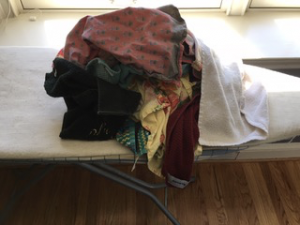
Take this example of table linens – out of the dryer and onto a folding surface.
Task Batched Folding Steps would look like this:
• Sort clean laundry into categories: if you mix loads from a whole household, your first sort job will be by person, then by category of clothing (socks, underwear, shirts that fold, shirts that hang, bottoms, work out clothing, pajamas…etc).
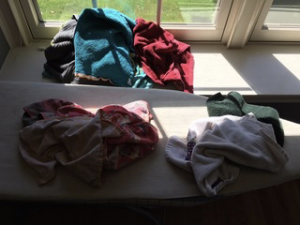
Step 1: sort into categories: this load broke down into hand towels, dish towels and cloth napkins.
• Prep each category so it’s ready to be folded (right any clothes that are inside out or button collars).
• Fold each category separately – meaning one category at a time – preferably on a clean and flat surface.
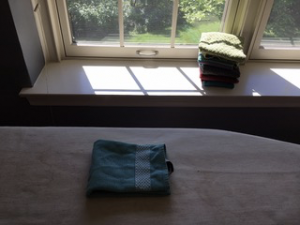
• Do all of your folding at once.
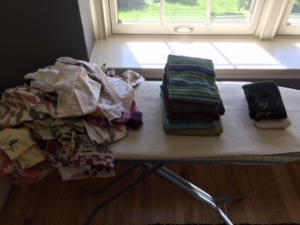
Step 2: fold each mini pile as its own category.
Our cloth napkins need to be ironed so they’ll stay on the ironing board.
The other 2 folded piles will go into their appropriate drawers in the kitchen.
Will task batching your folding process solve all of your laundry dilemma’s? No — but folding by category allows you to delegate small pieces of the project to even the youngest helpers and lets others take pride in the smooth running of the household if you’re lucky enough to live with people who will “volunteer” or as in our household, be volunteered to help 🙂
 If being organized is not how you were raised but you’ve started to become more orderly, you may already know: it takes time getting used to “being organized.”
If being organized is not how you were raised but you’ve started to become more orderly, you may already know: it takes time getting used to “being organized.”
I learned this with a new client: Kim (not her real name) has struggled all her life to maintain a neat space. Her efforts go in waves and she has managed to live a really rich and creative life — but it hasn’t been easy. She’s lost a few things along the way. Paid her share of late fees for bills and penalties for misplaced parking tickets. And wasted time rewashing clothes after the dirty commingled with the clean.
When she was ready to stop this chaos…she called in a professional organizer.
She had 3 areas to organize:
• her wardrobe and bedroom
• her living room – including a desk area
• her hallway which had become an over-crowded storage space
We started in her bedroom because the mess was affecting her sleep. After 3 working sessions we had sorted through all of her clothes, cleared every surface (including the floor) of anything that didn’t belong, rearranged her dresser drawers and closet with zones for each type of clothing she needed in her life.
Moving on to the living room, Kim sheepishly told me a “funny” story about her missing slippers. The one constant in Kim’s life had been lots of weekends away to cabins with friends. In preparing to pack for one such weekend, she described how she had scoured her apartment looking for her slippers.
She checked ALL of her usual spots: under the coffee table, in the bathroom, kicked under the hallway table, in a pile behind the couch, tucked under her bed, tossed into a corner by her cat…she couldn’t find them anywhere.
She left for her weekend sans slippers in a bummed mood.
As soon as she got on the road to the cabin, it hit her. She couldn’t help but laugh out loud. Her slippers were right where we had left them — in their new home. They were in the bottom “bay” of the hanging shoe organizer we had installed in her closet.
It was a funny lesson to us both, that getting organized takes some getting used to! The motto of Kim’s story is: It’s easy to find what you need when you need it…when it is right where you left it.
 Have you ever heard of BOGO? What about FOMO or YOLO?
Have you ever heard of BOGO? What about FOMO or YOLO?
These acronyms are clever and catchy:
BOGO: Buy One, Get One is an advertising phrase that encourages people to purchase because of the promise of a second item…whether they need it or not.
FOMO: Fear Of Missing Out is a phenomenon where people refuse to commit to plans or feel less present in their current activity because they wonder what they’re missing (that might be more fun).
YOLO: You Only Live Once is my youngest daughter’s favorite.
Ever heard of AUG? Don’t worry if you haven’t. Other than being the abbreviated version for this month, it is my attempt to be clever by encouraging de-cluttering throughout August. AUG stands for Anything Unused Goes!
AUG is an acronym that is very flexible. I invite you to get creative with the different ways you can use it to clear unused, useless and unworthy things from your life, space and storage areas.
How do you decide worth or usefulness? Please don’t decide worth solely by how much you spent or invested in something. Real worth is defined by how valuable it is to you today. Decide how necessary your stuff is to your life and its worth of the space it’s taking up in your home, car or office.
Lots of folks confuse usefulness with an item’s ability to still be useful – without considering if that item is of actual use to them. Today, there are so many ways to donate, repurpose and recycle things. Don’t hold onto things that clutter YOUR life. Let Anything Unused Go!

As a professional organizer, I help people deal with their stuff. Some clients hire me because they have too much stuff. Others because they don’t know how to store their stuff. And still others because they want to learn how to eliminate useless stuff from their lives. I don’t think you’re shocked to hear that I’ve never had to help a client feel less overwhelmed from owning too many cars or dishwashers. People are incredibly thoughtful when making large purchases. We keep in mind all of the costs involved and make sure the new item fills a need in our life and fits our lifestyle.
When we are considering spending a significant amount of money on a car, technology or household appliance, we examine a few key criteria:
• Will it do what I need it to do?
• Will it stay current long enough to warrant the investment?
• Will it integrate with what I already own?
• Is it the right size for the space?
• Can I handle it properly (car, computer, pet)?
• Is required service going to be easy or a hassle?
• Can I afford the maintenance?
These are all reasonable questions.
So why does sanity and sensibility go out the window when we purchase small ticket items? We don’t even think about need for items under a certain price point. We forget that the financial investment we’ll have to make is over the LIFE of the item, not just at the point of purchase. And we don’t look at the price on our life.
Clothes, school supplies, toiletries, kitchen gadgets and sports equipment are just some of the categories where people ignore that there are costs beyond the price at the register. And when someone makes enough poor purchases, there are lots of unseen, down-the-road prices to pay.
The cost is to our pocketbooks, living spaces, psyches and planet. We would do well to ask of each small item the same we ask — dare I say, DEMAND — of significant investments before we look at the selling price:
• Will this answer a real need in my life?
• Can I afford to store and maintain it?
• Do I have the time and mental space to learn how to enjoy it?
On this Cyber Monday, and throughout the holiday gift-giving season, it is even more important to consider, not just for yourself but for your friends and family, is this item worth the price? And remember, not every gift has to be a THING.
Click on the title above to learn more about the featured author.
 While I don’t personally know enough about college basketball teams to predict who will win this year’s March Madness Tournament, I do follow the excitement as my family creates detailed brackets and fans bet on their top picks.
While I don’t personally know enough about college basketball teams to predict who will win this year’s March Madness Tournament, I do follow the excitement as my family creates detailed brackets and fans bet on their top picks.
In my play book, we are all winners when we follow organizing rules inspired by the concept:

The less you stress…the more freedom you gain.
The less you buy…the more financial resources you maintain.
Make your own play and create MORE in your life with these tips:
M – More clarity in your priorities gives you more time and space for life.
A – Anyone can become organized when you structure your time.
R – Review your next day’s schedule the night before to eliminate surprises.
C – Carve out time daily for exercise, nutrition and sleep.
H – Handle any task that will take less than 2 minutes – now!
M – Make physical AND mental space in your life.
A – Add breathing room into your schedule for delays and transitions.
D – Delegating is a skill worth learning – develop a team mentality.
N – NAPO.net is your go-to for help if some rules seem beyond your reach.
E – Easy access is your goal for anything you use on a daily basis.
S – Simplify one area of your life today.
S – Stay focused on priorities for big playoffs…I mean big PAY-offs 🙂